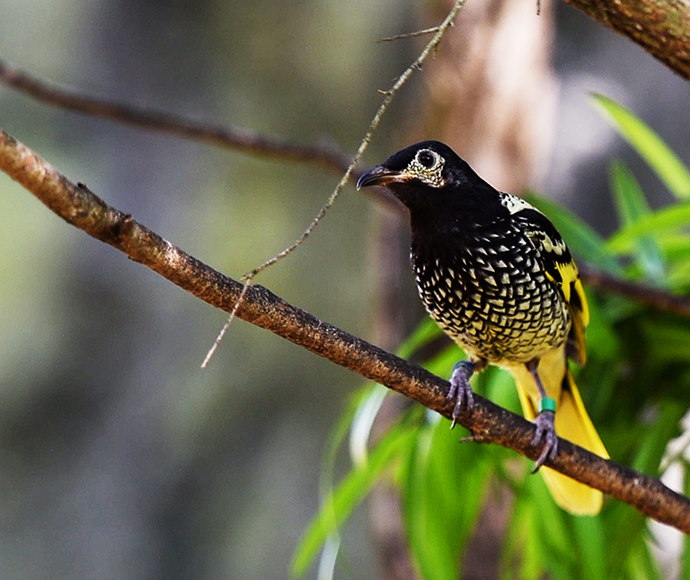Regent honeyeater sets a record for speed and distance
A critically endangered regent honeyeater named 'OG-Bling' has broken a record by flying 350 km in just 3 months.
A regent honeyeater released in Victoria was sighted 470 km away in south-western Sydney, however 2 years had passed between its release and the sighting in New South Wales.
It is estimated there are as few as 250 to 300 regent honeyeaters in the wild. OG-Bling was bred as part of a recovery program supported by Saving Our Species. He was one of 50 regent honeyeaters released in November 2022 in the Lower Hunter Valley, on land owned by Mindaribba Local Aboriginal Land Council.
OG-Bling was found and photographed in the same region in March and April by citizen scientists in Werakata State Conservation Area, near Kurri Kurri. He was observed socialising with 3 other zoo-bred regent honeyeaters and 5 wild honeyeaters. OG-Bling and the group then left the region, and after a record journey, he was photographed north of Coffs Harbour at the end of July.
The regent honeyeater breeding program is a conservation partnership between the NSW Government’s Saving our Species program, Taronga Conservation Society Australia and BirdLife Australia. Many of the birds are hatched and prepared for release at Taronga Western Plains Zoo in Dubbo, and Taronga Zoo in Sydney.
All birds bred in the program are identified by a combination of 4 leg bands. OG-Bling is named after the orange and green coloured plastic bands on his left leg. Like all 50 birds released in 2022, he has the 'Bling' of hot-pink and metal bands on his right leg. The metal band is provided by the Australian Bird and Bat Banding Scheme and is printed with a unique number that helps identify each individual, in the event they lose their plastic colour bands.
All sightings of Regent Honeyeaters should be reported to BirdLife Australia, online or on 1800 621 056.
Minister for the Environment Penny Sharpe says it’s an important step for the critically endangered species:
“It’s wonderful to see one of the country’s rarest birds survive and thrive after being released into the wild.
“I’ve been following the plight of the regent honeyeater for years, and it’s exciting to see conservation efforts making a real difference to bring these birds back from the brink.
“Thanks to the state’s citizen scientists for keeping a keen eye out for this celebrity regent honeyeater and I hope they find many more.”
Quotes attributable to BirdLife Australia’s Regent Honeyeater Recovery Coordinator Mick Roderick:
“That actual bird was already a bit of a celebrity from when birds were being seen near Kurri. Never before has a Regent Honeyeater been recorded flying so far in so short a time. This bird has blown the record out of the water.
“Citizen scientists are crucial to the recovery effort. Once we lose the ability to track the released birds using radio transmitters, it’s just so difficult to find them. We can be out there seven days a week and not find birds. It’s like a needle in a haystack.”
Quotes attributable to Dr Kim Maute, NSW Government’s Saving our Species principal ecologist:
“It’s really encouraging – a bird released in November travelling so far and so quickly.
“In winter, regent honeyeaters sometimes move towards the coast because spotted gum or swamp mahogany is flowering. This year the swamp mahogany is flowering very well.
“It shows the importance of having mature trees and a variety of habitat across the landscape.”
Quotes attributable to Dr Monique Van Sluys , Taronga Conservation Society Australia:
“So much care and effort goes into breeding and caring for these birds in Sydney and Dubbo, as well as ensuring we use conservation science to optimise their survival post release.
“After more than 2 decades working with this iconic species, to know we’re making improvements and seeing record-breaking results motivates us to keep working with our partners to ensure this beautiful bird flourishes.”
